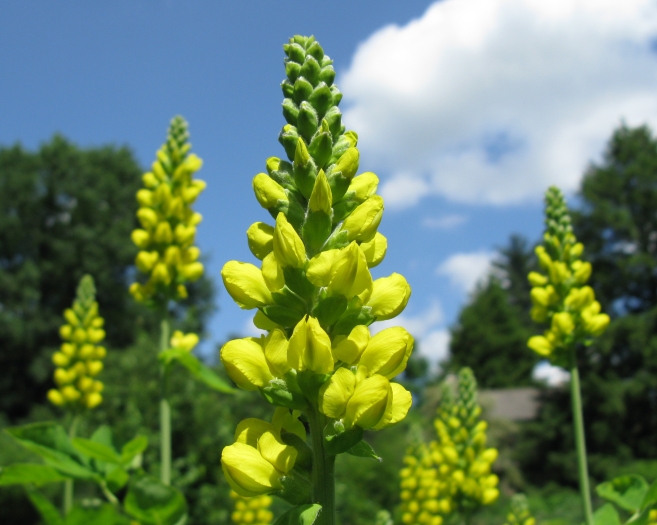Carolina Lupine
(Thermopsis villosa)
Carolina Lupine (Thermopsis villosa)
/
/

Bob Gutowski
CC BY 2.0
Image By:
Bob Gutowski
Recorded By:
Copyright:
CC BY 2.0
Copyright Notice:
Photo by: Bob Gutowski | License Type: CC BY 2.0 | License URL: https://creativecommons.org/licenses/by/2.0 | Uploader: Flickr upload bot | Publisher: Wikimedia Commons | Title: Thermopsis_villosa_(syn._T.caroliniana),_Carolina_lupine.jpg | Notes: |

































Estimated Native Range
Summary
Thermopsis villosa, commonly known as Carolina Lupine or Aaron’s Rod, is a deciduous perennial herb native to open woodlands and meadows in the Southeastern United States. It typically grows to a height of 3-5 feet (0.9-1.5 meters) and a width of 2-3 feet (0.6-0.9 meters). This plant features erect racemes of showy, bright yellow flowers that resemble those of the lupine, blooming from late spring to early summer. The foliage is attractive, with compound leaves that are hairy and blue-green in color.
Carolina Lupine is valued for its vibrant yellow flowers and ability to add vertical interest to garden beds and borders. It is a low-maintenance plant that is used for naturalizing in meadows, as well as in perennial borders and cottage gardens. It thrives in full sun but can tolerate light shade and prefers well-drained soils. While it is drought-tolerant once established, consistent moisture will promote better flowering. Carolina Lupine is not commonly afflicted by serious pests or diseases, but it can be susceptible to root rot in poorly drained soils. It is not known to be invasive and does not have aggressive roots, making it a safe choice for most garden settings.CC BY-SA 4.0
Carolina Lupine is valued for its vibrant yellow flowers and ability to add vertical interest to garden beds and borders. It is a low-maintenance plant that is used for naturalizing in meadows, as well as in perennial borders and cottage gardens. It thrives in full sun but can tolerate light shade and prefers well-drained soils. While it is drought-tolerant once established, consistent moisture will promote better flowering. Carolina Lupine is not commonly afflicted by serious pests or diseases, but it can be susceptible to root rot in poorly drained soils. It is not known to be invasive and does not have aggressive roots, making it a safe choice for most garden settings.CC BY-SA 4.0
Plant Description
- Plant Type: Herb
- Height: 3-5 feet
- Width: 2-3 feet
- Growth Rate: Moderate
- Flower Color: Yellow
- Flowering Season: Summer
- Leaf Retention: Deciduous
Growth Requirements
- Sun: Full Sun
- Water: Medium
- Drainage: Medium
Common Uses
Bird Garden, Border Plant, Drought Tolerant, Low Maintenance, Showy Flowers
Natural Habitat
Open woodlands and meadows
Other Names
Common Names:
Scientific Names: , Thermopsis villosa, Thermopsis caroliniana, Baptisia villosa, Sophora villosa, Lasinia fulva, Podalyria villosa,
GBIF Accepted Name: Thermopsis villosa (Walter) Fernald & B.G.Schub.